Abstract
Adenomatoid odontogenic tumor (AOT) is an uncommon benign tumor of odontogenic origin composed of odontogenic epithelium in a variety of histopathological patterns. These lesions are usually solid but are occasionally cystic. AOT has been reported to occur in association with odontogenic cysts. Very few cases have been described that arise in association with a dentigerous cyst. A systematic search of the English-language medical literature in PubMed and Medline search (keywords adenomatoid odontogenic tumor, dentigerous cyst) data bases revealed only ten such cases.
The present case is very unique, exceptional and first of this kind that occurred in the posterior mandible associated with an impacted lower first premolar in a 19-year old female patient. The intraosseous follicular AOT, as this case reported here, frequently resemble dentigerous cysts. There is an uncertainty whether the lining of an associated cyst represents a true dentigerous cyst, cystic change within an AOT or may represent a distinct entity. We believe that this case represents an odontogenic cyst with neoplastic change. Hence, in such cases, the final diagnosis should be made on the basis of histological examination of extensive tissue sampling of entire excised tissue specimen. Further studies to determine whether the AOT derived from an odontogenic cyst could represent a distinct variant are to be done.
Keywords: Adenomatoid odontogenic tumor, Dentigerous cyst, Impacted tooth, Unilocular
Background
AOT is an uncommon tumor of odontogenic origin, composed of odontogenic epithelium in a variety of histological patterns. The lesion is benign (hamartomatous) and noninvasive, with slow but progressive growth. It accounts for 2–7 % of all odontogenic tumors and is less frequent. The epithelial lining of the odontogenic cyst may transform into an odontogenic neoplasm-like ameloblastoma or AOT [1–3]. There are very few reports of odontogenic tumors either arising from or associated with odontogenic cysts. Such unusual lesions must be carefully diagnosed by an oral pathologist so that best possible treatment needs of the patient can be met. The purpose of this article is to present a rare case of AOT that originated in the wall of a dentigerous cyst.
Case Report
A 19-year old female patient reported to Department of Oral and Maxillofacial Surgery, with a chief complaint of swelling in the left back region of the lower jaw since 2 months. The associated symptoms included discomfort during chewing of food. The patient was asymptomatic before 2 months and the swelling was slow growing and increased to the present size. Dull intermittent pain was also noted and she visited a local doctor, one week back and the medication given by him didn’t relieve pain. Extra orally, a single diffuse swelling on the left side of face extended from the corner of the mouth to the angle of the mandible and lower border of the mandible inferiorly. Intraoral examination revealed a well-defined swelling of 3.5 × 2 cm size in the buccal vestibule extending from the lateral incisor to the first molar of the same side (Fig. 1). On palpation the swelling was firm, slightly tender and showed egg-shell crackling. Clinically first premolar was missing. The overlying mucosa was non-ulcerated and pink in color.
Fig. 1.
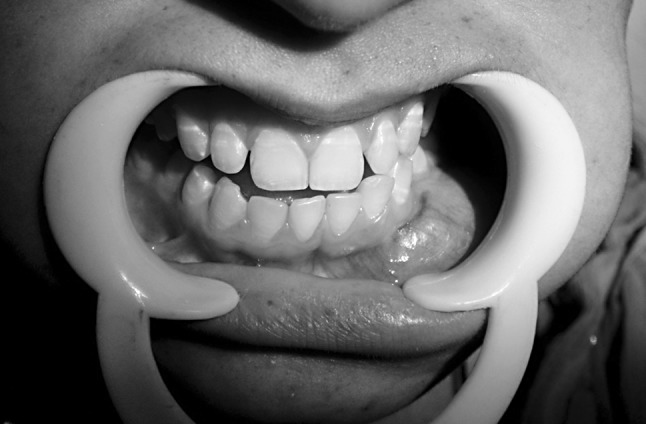
Clinical photograph showing the swelling in the lower left buccal vestibule
Orthopantomogram (OPG) and intra oral periapical (IOPA) radiographs revealed a well-defined, unilocular radiolucent lesion associated with an impacted first premolar (Fig. 2). The lesion was extending from parasymphysis region to first molar area and the associated tooth was displaced to the lower border of the mandible.
Fig. 2.
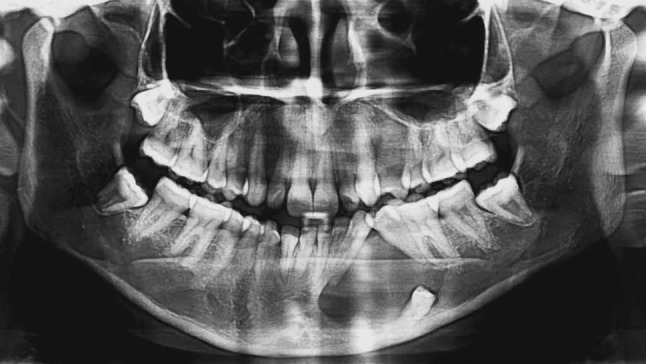
OPG shows a well-defined, unilocular radiolucent lesion with an impacted first premolar
Based on the clinical and radiographic findings, the differential diagnosis of dentigerous cyst, AOT and odontogenic keratocyst were made. Aspiration of the cystic lesion revealed a straw colored fluid of about 1 ml and the protein analysis of the same was 5.2 mg/dl. The patient underwent surgical curettage under local anesthesia (Fig. 3). Excised tissue specimen along with the embedded first premolar was submitted for the histopathological examination.
Fig. 3.
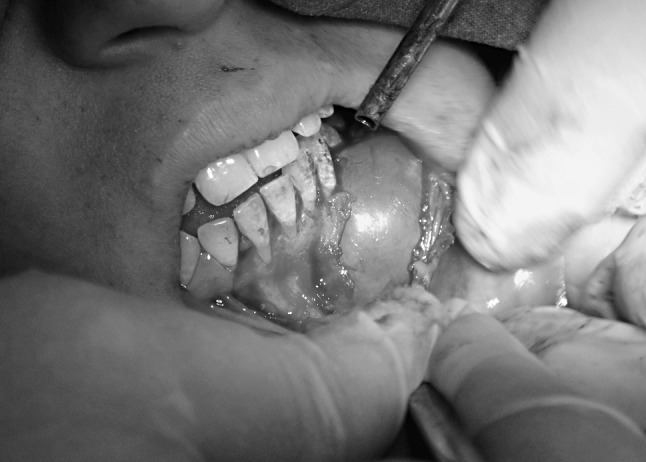
Intra-operative photograph showing the lesion after the incision and flap reflection
Microscopically, H & E stained sections of the excised specimen showed a cystic lining of nonkeratinized stratified squamous epithelium of 2–3 cell thickness (Fig. 4) with focal areas of luminal proliferation of islands of spindle shaped epithelial cells and some arranged in a rosette pattern (Fig. 5). The tissue from the lesion contained islands of odontogenic epithelium with formation of rosette like structures (Fig. 6). The underlying connective tissue showed collagen fibers arranged in bundles with areas of hyalinization, few epithelial rest cells and blood vessels. The diagnosis of AOT in a pre-existing dentigerous cyst was made. The healing was uneventful without any complications (Fig. 7) and is under follow-up once in 3 months.
Fig. 4.

Photomicrograph showing the nonkeratinised stratified squamous epithelium lining typical of dentigerous cyst (H & E stain × 100)
Fig. 5.
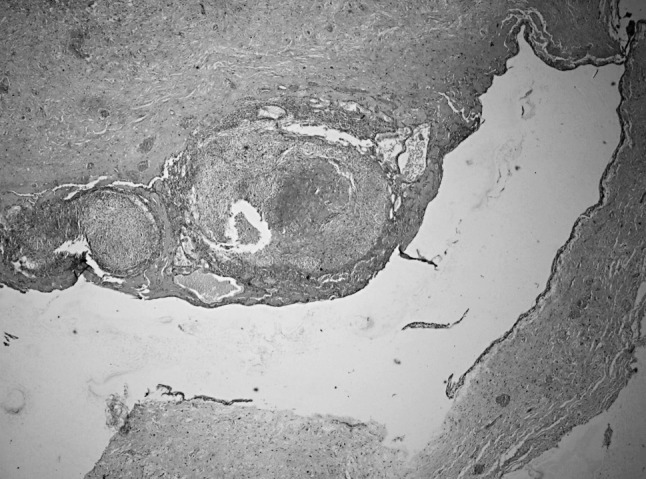
Photomicrograph showing of nonkeratinized stratified squamous epithelial lining of 2–3 cell thickness with focal areas of luminal proliferation
Fig. 6.
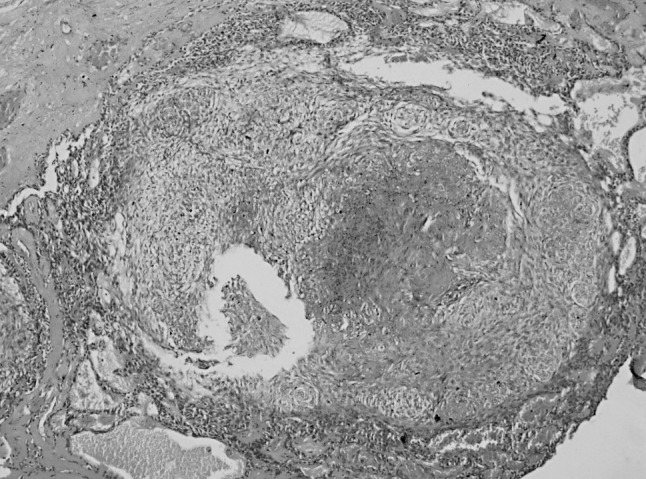
Photomicrograph showing islands of spindle shaped odontogenic epithelial cells arranged in a rosette pattern confirming adenomatoid odontogenic tumor
Fig. 7.
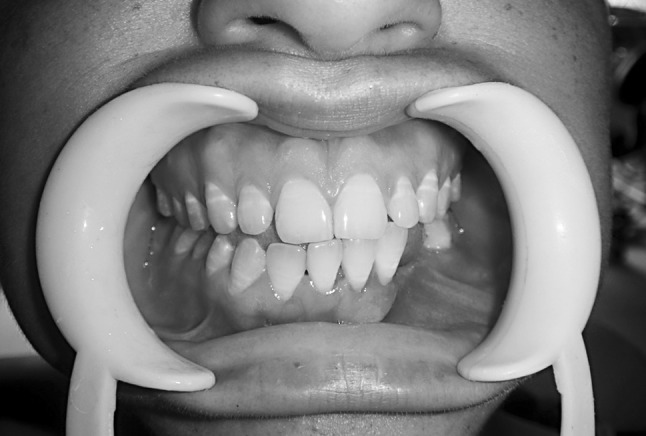
Photomicrograph showing post-operative healing after 2 weeks of follow-up
Discussion
AOT, an uncommon benign epithelial lesion of odontogenic origin, was first described by Dreibaldt in 1907 as ‘Pseudoadenoameloblastoma’ [4]. Harbitz in 1915 reported it as ‘Cystic Adamantoma’ [5]. Stafne in 1948, considered it as a distinct entity and the term “Adenomatoid Odontogenic Tumor” was proposed in 1969 by Philipsen and Birn [6, 7]. WHO has described AOT as “A tumor of odontogenic epithelium with duct-like structures and with varying degrees of inductive change in the connective tissue”. The tumor may be partly cystic, and in some cases the solid lesion may be present only as masses in the wall of a large cyst [8].
Various terms such as adenoameloblastoma, ameloblastic adenomatoid tumor, adamantinoma, epithelioma adamantinum or teratomatous odontoma were used earlier to describe the lesion [6].
AOT is a benign lesion derived from the complex system of dental lamina or its remnant. It has been reported that some odontogenic cysts occur in association with odontogenic tumors [4]. There is an uncertainty whether the lining of an associated cyst represents a true dentigerous cyst, cystic change within an AOT or may represent a distinct entity. However, it is unclear whether this entity has a more aggressive potential. Most central AOT’s occur in a pericoronal relationship with an associated tooth; there is no way to be certain whether the lining of an associated cyst represents a true dentigerous cyst or a secondary cystic change within the AOT [9].
Very few cases have been described that arise in association with a dentigerous cyst. Garcia-Pola et al. [10] have described the proliferation of an AOT in the epithelial lining of a dentigerous cyst. Tajima et al. [11] described an AOT located in the superior portion of the maxillary sinus and speculated that the tumor was derived from a dentigerous cyst. Philipsen et al. [7, 12, 13] have also postulated that the follicular type of AOT develops from nests of cells within the dental lamina and hence surrounds the tooth.
Because neoplastic and hamartomatous lesions can occur at any stage of odontogenesis, odontogenic tumors with combined features of epithelial and mesenchymal components may arise within the odontogenic cyst [9]. The epithelial lining of the odontogenic cyst may transform into an odontogenic neoplasm-like ameloblastoma or AOT. There have been many reports of odontogenic cysts associated with odontogenic tumors [2, 3]. On occasion some untreated dentigerous cysts rarely but have potential to undergo neoplastic transformation into squamous cell carcinoma and mucoepidermoid carcinoma which is extremely rare [14].
Rick et al. have reported AOT to occur with many types of cysts and neoplasms including dentigerous cyst, calcifying odontogenic cyst, odontoma, ameloblastoma, etc. Some of these cysts are lined by nonkeratinized stratified squamous epithelium which is similar to the lining of the dentigerous cyst or lined by less structured membrane that may demonstrate bud like extensions into the connective tissue [9].
The systematic review of the English-language medical literature of AOTs associated with or originating from a dentigerous cyst showed only 10 matching reports excluding the present case [10, 11, 15, 16, 17–22]. PubMed and Medline search was done using the keywords ‘adenomatoid odontogenic tumor’ and ‘dentigerous cyst’ for the review of literature.
The summary of the age, site, radiographic and clinical presentation of the previous reports of AOT showing a cystic lining histologically are listed in Table 1.
Table 1.
Clinical and radiographic details of previously reported cases in the English literature
| Sl. no | Author | Year | Age/gendera | Clinical featuresb | Site | Radiographic details |
|---|---|---|---|---|---|---|
| 1 | Valderrama [17] | 1988 | 16/F | Impacted 14 | Maxilla | Unilocular |
| 2 | Warter et al. [15] | 1990 | 8/M | Impacted 13 | Maxilla | Unilocular |
| 3 | Tajima et al. [11] | 1992 | 15/M | Unerupted crown of 28 | Maxillary Sinus | Radiopaque mass |
| 4 | Garcia-Pola Vallejo et al. [10] | 1998 | 12/M | Impacted 23 | Maxilla | Unilocular |
| 5 | Takahashi et al. [18] | 2001 | 22/M | Impacted 28 | Maxilla | Unilocular |
| 6 | Bravo et al. [19] | 2005 | 14/M | Impacted 23 | Maxilla | Unilocular |
| 7 | Nonaka et al. [20] | 2007 | 13/F | Impacted 23, 24 | Maxilla | Unilocular |
| 8 | Sandhu et al. [16] | 2010 | 25/F | Impacted 13 | Maxillary sinus | Unilocular |
| 9 | John and John [21] | 2010 | 39/F | Impacted 27 | Maxilla and maxillary sinus | Unilocular |
| 10 | Moosvi et al. [22] | 2011 | 13/F | Impacted 32 | Mandible | Unilocular |
aAge in years, F Female, M Male
bFDI system of tooth numbering is used
Out of 10 cases from the literature review showed that the age range of patient was from 8 to 39 years with the mean age of 17.6 years. The male to female ratio is equal which is contrary to classical AOT which is common in females. All the previously reported cases were associated with impacted or unerupted tooth. Most cases occurred in the maxilla [10, 15, 17–20] and two are associated with the maxillary sinus [11, 16]. One case was seen both in the maxilla as well as the adjacent maxillary sinus [21]. Of these, only 3 cases occurred in the posterior region of the jaw [11, 18, 21] and most of them were associated with impacted canine. We believe that the present case is very exceptional and first case to be documented that occurred in the posterior mandible. All previous cases [10, 15, 16, 17–22] showed unilocular radiolucency except for one case presented as a well-defined radiopaque mass [11]. Recently, Moosvi et al. [22], have reported a similar case of AOT arising from DC in the anterior part of mandible with a well defined radiolucency extending from 33 to 42 associated with an impacted left lateral incisor showing same histological features as described in the present case.
The lining of a cystic AOT may present as thin non-keratinised stratified squamous lining epithelium, exhibiting nodule formation [3, 10] and subepithelial hyalinization (present case). The cystic lining may transform into nodular thickening [3, 10]. In the present case, histological features of dentigerous cyst lining and AOT in the form of nodules and rosette validate the transformation of cystic lining to neoplasm. This feature was also observed in case reports by Warter et al., Sandhu et al., Nonaka et al. and others [15, 16, 20].
It is unclear whether this entity (AOT arising from dentigerous cyst) has a more aggressive potential. The AOT and dentigerous cyst are both benign, encapsulated lesions and conservative surgical enucleation or curettage is the treatment of choice. The prognosis for a dentigerous cyst is good and recurrences are very rare after complete removal of the lesion [16].
We hypothesize that all the previously described cases represent the cystic variant of AOT. The nodular growth in the cystic lining seen in the review supports the existence of a subset of follicular AOT which originates from a cyst. Though the classical clinicopathological features of AOT were evident, the histological variant reported is indeed a rarity. We believe that the present case represents an odontogenic cyst with neoplastic transformation. Meticulous histopathological evaluation of all tissue bits of enucleated cysts, which could contribute to the diagnosis of similar cases as reported here.
To conclude, the present report describes a rare case of AOT associated with a dentigerous cyst occurring in the posterior region of lower jaw with an impacted left first premolar, highlighting the importance of the histopathological examination in the cystic lesions of the jaw bones. Furthermore, this case is first of its kind occurring in the posterior part of the mandible.
Conflict of interest
The authors declare that they have no conflict of interest in the preparation and publication of this article.
References
- 1.Chuan-Xiang Z, Yan G. Adenomatoid odontogenic tumor: a report of a rare case with recurrence. J Oral Pathol Med. 2007;36(7):440–443. doi: 10.1111/j.1600-0714.2007.00521.x. [DOI] [PubMed] [Google Scholar]
- 2.McMillan MD, Smillie AC. Ameloblastomas associated with dentigerous cysts. Oral Surg Oral Med Oral Pathol. 1981;51(5):489–496. doi: 10.1016/0030-4220(81)90008-6. [DOI] [PubMed] [Google Scholar]
- 3.Jivan V, Altini M, Meer S, Mahomed F. Adenomatoid odontogenic tumor (AOT) originating in a unicystic ameloblastoma: a case report. Head Neck Pathol. 2007;1(2):146–149. doi: 10.1007/s12105-007-0005-6. [DOI] [PMC free article] [PubMed] [Google Scholar]
- 4.Batra P, Prasad S, Parkash H. Adenomatoid odontogenic tumour: review and case report. J Can Dent Assoc. 2005;71(4):250–253. [PubMed] [Google Scholar]
- 5.Philipsen HP, Reichart PA, Siar CH, Ng KH, Lau SH, Zhang X, et al. An updated clinical and epidemiological profile of the adenomatoid odontogenic tumour: a collaborative retrospective study. J Oral Pathol Med. 2007;36(7):383–393. doi: 10.1111/j.1600-0714.2007.00536.x. [DOI] [PubMed] [Google Scholar]
- 6.Lee JK, Lee KB, Hwang BN. Adenomatoid odontogenic tumor: a case report. J Oral Maxillofac Surg. 2000;58(10):1161–1164. doi: 10.1053/joms.2000.9581. [DOI] [PubMed] [Google Scholar]
- 7.Philipsen HP, Birn H. The adenomatoid odontogenic tumour. Ameloblastic adenomatoid tumour or adeno-ameloblastoma. Acta Pathol Microbiol Scand. 1969;75(3):375–398. [PubMed] [Google Scholar]
- 8.Unal T, Cetingul E, Gunbay T. Peripheral adenomatoid odontogenic tumor: birth of a term. J Clin Pediatr Dent. 1995;19(2):139–142. [PubMed] [Google Scholar]
- 9.Rick GM. Adenomatoid odontogenic tumor. Oral Maxillofac Surg Clin North Am. 2004;16(3):333–354. doi: 10.1016/j.coms.2004.04.001. [DOI] [PubMed] [Google Scholar]
- 10.Garcia-Pola Vallejo M, Gonzalez Garcia M, Lopez-Arranz JS, Herrero Zapatero A. Adenomatoid odontogenic tumor arising in a dental cyst: report of unusual case. J Clin Pediatr Dent. 1998;23(1):55–58. [PubMed] [Google Scholar]
- 11.Tajima Y, Sakamoto E, Yamamoto Y. Odontogenic cyst giving rise to an adenomatoid odontogenic tumor: report of a case with peculiar features. J Oral Maxillofac Surg. 1992;50(2):190–193. doi: 10.1016/0278-2391(92)90370-F. [DOI] [PubMed] [Google Scholar]
- 12.Philipsen HP, Samman N, Ormiston IW, Wu PC, Reichart PA. Variants of the adenomatoid odontogenic tumor with a note on tumor origin. J Oral Pathol Med. 1992;21(8):348–352. doi: 10.1111/j.1600-0714.1992.tb01363.x. [DOI] [PubMed] [Google Scholar]
- 13.Philipsen HP, Reichart PA, Zhang KH, Nikai H, Yu QX. Adenomatoid odontogenic tumor: biologic profile based on 499 cases. J Oral Pathol Med. 1991;20(4):149–158. doi: 10.1111/j.1600-0714.1991.tb00912.x. [DOI] [PubMed] [Google Scholar]
- 14.Slootweg PJ. Carcinoma arising from reduced enamel epithelium. J Oral Pathol. 1987;16(10):479–482. doi: 10.1111/j.1600-0714.1987.tb00676.x. [DOI] [PubMed] [Google Scholar]
- 15.Warter A, George-Diolombi G, Chazal M, Ango A. Melanin in a dentigerous cyst and associated adenomatoid odontogenic tumor. Cancer. 1990;66(4):786–788. doi: 10.1002/1097-0142(19900815)66:4<786::AID-CNCR2820660431>3.0.CO;2-0. [DOI] [PubMed] [Google Scholar]
- 16.Sandhu SV, Narang RS, Jawanda M, Rai S. Adenomatoid odontogenic tumor associated with dentigerous cyst of the maxillary antrum: a rare entity. J Oral Maxillofac Pathol. 2010;14(1):24–28. doi: 10.4103/0973-029X.64308. [DOI] [PMC free article] [PubMed] [Google Scholar]
- 17.Valderrama LS. Dentigerous cyst with intracystic adenomatoid odontogenic tumor and complex odontoma. J Philipp Dent Assoc 1988 Dec–1989 Jan; 41(3):35–41 [PubMed]
- 18.Takahashi K, Yoshino T, Hashimoto S. Unusually large cystic adenomatoid odontogenic tumour of the maxilla: case report. Int J Oral Maxillofac Surg. 2001;30(2):173–175. doi: 10.1054/ijom.2000.0003. [DOI] [PubMed] [Google Scholar]
- 19.Bravo M, White D, Miles L, Cotton R. Adenomatoid odontogenic tumor mimicking a dentigerous cyst. Int J Pediatr Otorhinolaryngol. 2005;69(12):1685–1688. doi: 10.1016/j.ijporl.2005.03.055. [DOI] [PubMed] [Google Scholar]
- 20.Nonaka CF, de Souza LB, Quinderé LB. Adenomatoid odontogenic tumour associated with dentigerous cyst—unusual case report. Braz J Otorhinolaryngol. 2007;73(1):129–131. doi: 10.1016/S1808-8694(15)31135-6. [DOI] [PMC free article] [PubMed] [Google Scholar]
- 21.John JB, John RR. Adenomatoid odontogenic tumor associated with dentigerous cyst in posterior maxilla: a case report and review of literature. J Oral Maxillofac Pathol. 2010;14(2):59–62. doi: 10.4103/0973-029X.72502. [DOI] [PMC free article] [PubMed] [Google Scholar]
- 22.Moosvi Z, Tayaar SA, Kumar GS. Neoplastic potential of odontogenic cysts. Contemp Clin Dent. 2011;2(2):106–109. doi: 10.4103/0976-237X.83073. [DOI] [PMC free article] [PubMed] [Google Scholar]


